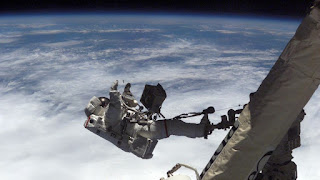Astronauts Are Finally Able to Clean Their Undies
Whenever you see an image of someone working at JPL on a rover or satellite, you always see them wearing clean suits. This is because scientists don’t want to get any tiny debris or dust on the pieces which can cost lots of money. You would think the same would apply to the astronauts in spaceships or satellites. And for the most part, you would be correct. Astronauts quarantine before they enter space to make sure that all the astronauts are healthy and no harmful bacteria is brought to space. However, one thing that an astronaut almost never cleans is their underwear, but new technology may change all of that.
 |
| LCVG |
For the last two years, the ESA has been working on a project called Biocidal Advanced Coating Technology for Reducing Microbial Activity or Bacterma for short. As a part of this project, the ESA is collaborating with the Vienna Textile Lab - a private biotech company in Austria that produces fabric dyes from bacteria. Other compounds can also be created by these bacteria that can make textile fibers more resistant to certain types of microbes.
 |
| View from an Electron Microscope of the Newly Developed LCVGs |
However, don’t get the impression that astronauts aren’t clean. They still keep their hands and bodies clean with dry shampoo and no-rinse clothing. But, since laundering clothes takes too much water, astronauts can’t clean their clothes in space. Additionally, astronauts don’t have enough room for the ISS to pack a fresh change of clothes for every day of their mission. Instead, astronauts often wear the same pairs of clothing more than once. Some astronauts even said they wear the same clothes for three to four days at a time. Whenever clothes become too smelly, they are either returned back to Earth or ejected into space.
 |
| Astronaut David A. Wolf on a Spacewalk in 2002 |
The ESA is also working on upgrading the outer material of spacesuits to get rid of bacteria. Soon, the ESA will test the performance of the antimicrobial properties in the new LCVGs by exposing them to sweat, lunar dust, and radiation to simulate how the garments would react in space. Soon, astronauts will be one step closer to being cleaner.
 |
| 2 Astronauts in Their LCVG Ready to Suit Up in Their Spacesuits in Preparation for a Spacewalk |
Sources:
“Home.” Texas A&M University College of Engineering, ahsl.engr.tamu.edu/research/thermal-modeling-of-lcvg/.
Weisberger, Mindy. “Astronauts May Finally Start Cleaning Their Space Underwear (with Microbes).” Space.com, Space, 19 May 2021, www.space.com/astronauts-shared-underwear-upgrade.


Comments
Post a Comment